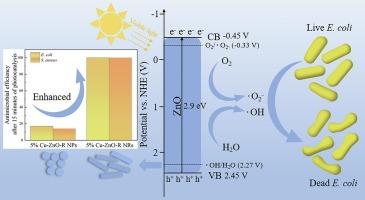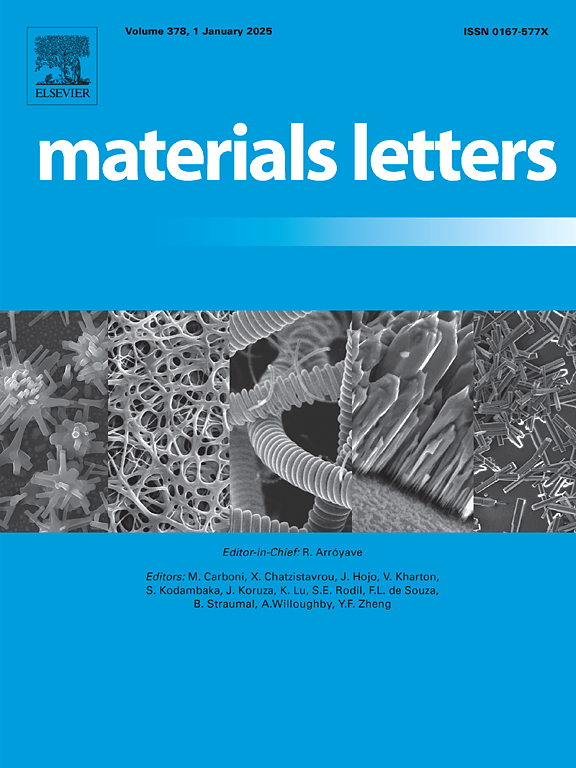Antimicrobial activities of oxygen-vacancy-engineered copper-doped zinc oxide nanoparticles and nanorods
IF 2.7
4区 材料科学
Q3 MATERIALS SCIENCE, MULTIDISCIPLINARY
引用次数: 0
Abstract
In this study, copper-doped zinc oxide with oxygen vacancies reduced by sodium borohydride (Cu-ZnO-R) was synthesized in the forms of nanoparticles and nanorods. The characterization by X-ray diffraction (XRD), scanning electron microscopy (SEM), X-ray photoelectron spectroscopy (XPS), electron spin resonance (ESR), and transmission electron microscopy (TEM) provided evidence for the successful synthesis of copper-doped ZnO nanorods with reduced oxygen vacancies. The photocatalytic antimicrobial tests against Escherichia coli, Staphylococcus aureus and Thielaviopsis basicola were performed. The disinfection results showed that the introduction of oxygen vacancies and copper doping significantly enhanced the disinfection efficiency of the nanorods under both illuminated and dark conditions.

氧空位工程铜掺杂氧化锌纳米颗粒和纳米棒的抗菌活性
本研究以纳米粒子和纳米棒的形式合成了硼氢化钠还原氧空位的铜掺杂氧化锌(Cu-ZnO-R)。通过x射线衍射(XRD)、扫描电子显微镜(SEM)、x射线光电子能谱(XPS)、电子自旋共振(ESR)和透射电子显微镜(TEM)对ZnO纳米棒进行了表征,为成功合成氧空位减少的铜掺杂ZnO纳米棒提供了证据。对大肠杆菌、金黄色葡萄球菌和基氏蒂拉维opsis进行了光催化抑菌试验。消毒结果表明,在光照和黑暗条件下,引入氧空位和铜掺杂均显著提高了纳米棒的消毒效率。
本文章由计算机程序翻译,如有差异,请以英文原文为准。
求助全文
约1分钟内获得全文
求助全文
来源期刊

Materials Letters
工程技术-材料科学:综合
CiteScore
5.60
自引率
3.30%
发文量
1948
审稿时长
50 days
期刊介绍:
Materials Letters has an open access mirror journal Materials Letters: X, sharing the same aims and scope, editorial team, submission system and rigorous peer review.
Materials Letters is dedicated to publishing novel, cutting edge reports of broad interest to the materials community. The journal provides a forum for materials scientists and engineers, physicists, and chemists to rapidly communicate on the most important topics in the field of materials.
Contributions include, but are not limited to, a variety of topics such as:
• Materials - Metals and alloys, amorphous solids, ceramics, composites, polymers, semiconductors
• Applications - Structural, opto-electronic, magnetic, medical, MEMS, sensors, smart
• Characterization - Analytical, microscopy, scanning probes, nanoscopic, optical, electrical, magnetic, acoustic, spectroscopic, diffraction
• Novel Materials - Micro and nanostructures (nanowires, nanotubes, nanoparticles), nanocomposites, thin films, superlattices, quantum dots.
• Processing - Crystal growth, thin film processing, sol-gel processing, mechanical processing, assembly, nanocrystalline processing.
• Properties - Mechanical, magnetic, optical, electrical, ferroelectric, thermal, interfacial, transport, thermodynamic
• Synthesis - Quenching, solid state, solidification, solution synthesis, vapor deposition, high pressure, explosive
 求助内容:
求助内容: 应助结果提醒方式:
应助结果提醒方式:


